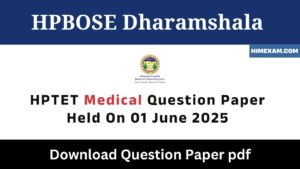Table of Contents
ToggleImportant Indian History Question Answer In English Set-8
||Important Indian History Question Answer In English Set-8||Important Indian History Question Answer for hpssc/hpsssb Set-8||
71. Ashoka called the Third Buddhist Council at
(A) Pataliputra
(B) Magadha
(C) Kalinga
(D) Sarnath
Explanation:-The Third Buddhist council was convened in about 250 BCE at Asokarama in Pataliputra, supposedly under the patronage of Emperor Asoka. The traditional reason for convening the Third Buddhist Council is reported to have been to rid the Sangha of corruption and bogus monks who held heretical views. It was presided over by the Elder Moggaliputta Tissa and one thousand monks participated in the Council.
72. The tutor of Alexander, the Great was
(A) Darius
(B) Cyrus
(C) Socrates
(D) Aristotle
Explanation:-Aristotle was a Greek philosopher and polymath, a student of Plato and teacher of Alexander the Great. Together with Plato and Socrates (Plato’s teacher), Aristotle is one of the most important founding figures in Western philosophy. Aristotle’s writings were the first to create a comprehensive system of Western philosophy, encompassing morality, aesthetics, logic, science, politics, and metaphysics. Aristotle was invited by Philip II of Macedon to become the tutor to his son Alexander in 343 BC. Aristotle was appointed as the head of the royal academy of Macedon. During that time he gave lessons not only to Alexander, but also to two other future kings: Ptolemy and Cassander. Aristotle encouraged Alexander toward eastern conquest.
73. Which of the following literary works belongs to classical Sanskrit literature?
(A) Dhammapada
(B) Vedas
(C) Meghadutam
(D) Dighanikaya
Explanation:-Meghadutam (cloud messenger) is a lyric poem written by Kalidasa, considered to be one of the greatest Sanskrit poets. In Sanskrit literature, the poetic conceit used in the Meghadutam spawned the genre of sandesha kavya or messenger poems, most of which are modeled on the Meghaduta (and are often written in the Meghaduta’s mandakranta metre)
74. Who propounded the ‘Eight-Fold Path’ for the end of misery of mankind ?
(A) Mahavir
(B) Gautam Buddha
(C) Adi Shankaracharya
(D) Kabir
Explanation:-The Noble Eightfold Path is one of the principal teachings of the Buddha, who described it as the way leading to the cessation of suffering (dukkha) and the achievement of self-awakening. It is used to develop insight into the true nature of phenomena (or reality) and to eradicate greed, hatred, and delusion. The Noble Eightfold Path is the fourth of the Buddha’s Four Noble Truths; the first element of the Noble Eightfold Path is, in turn, an understanding of the Four Noble Truths. It is also known as the Middle Path or Middle Way.
75. The number system ‘Zero’ was invented by
(A) Ramanujam
(B) Aryabhatta
(C) Patanjali
(D) An unknown person
Explanation:-The concept of zero as a number and not merely a symbol for separation is attributed to India, where, by the 9th century AD, practical calculations were carried out using zero, which was treated like any other number, even in case of division. The credit for inventing ‘zero (0)’ goes to Indian mathematicians and the number zero first appears in a book about ‘arithmetic’ written by an Indian mathematician ‘Brahamagupta’. Zero signifies ‘nothing’ and the current definition calls it an ‘additive identity’. The Indian mathematicians Bhaskara, Mahavira and Brahamagupta worked on this new number and they tried to explain its properties. It wasn’t that somebody suddenly came up with the idea of the zero and the mathematicians throughout the world accepted it. Around 500 AD, Aryabhatta, an Indian mathematician, devised a numbers system and the symbol he used for the number zero was also the number used to represent an unknown element
76. ‘Charak’ was the famous court physician of
(A) Harsha
(B) Chandra Gupta Maurya
(C) Ashoka
(D) Kanishka
Explanation:-Charaka was one of the principal contributors to the ancient art and science of Ayurveda, a system of medicine and lifestyle developed in Ancient India. He is referred to as the Father of Medicine. The life and times of Charaka are not known with certainty. Some Indian scholars have stated that Charaka of Charaka Samhita existed before Panini, the grammarian, who is said to have lived before the sixth century B. C. Another school argues that Patanjali wrote a commentary on the medical work of Charaka. They say that if Patanjali lived around 175 B.C., Charaka must have lived some time before him. Another source about the identity of Charaka and his times is provided by the French orientalist Sylvan Levi. He discovered in the Chinese translation of the Buddhist Tripitaka, a per- son named Charaka who was a court physician to the Indo-Scythian king Kanishka, who in all probability reigned in the second century A.D. From the above discussion, it would seem that Charaka may have lived between the second century B.C. to the second century A.D.
77. Buddhism made an important impact by allowing two sections of society into its fold. They were
(A) Merchants and Priests
(B) Moneylenders and Slaves
(C) Warriors and Traders
(D) Women and Sudras
Explanation:-Buddha was against caste. His religion was open to all, to shudras, women and even repentant criminals. The Buddhist scriptures were available to all men and women. Buddhism encouraged abolition of distinctions in society and strengthened the principle of social equality.
78. The language used to write source materials in ancient time was
(A) Sanskrit
(B) Pali
(C) Brahmi
(D) Kharosthi
Explanation:-Pali is a Middle Indo-Aryan language (of Prakrit group) of the Indian subcontinent. It is best known as the language of many of the earliest extant Buddhist scriptures, as collected in the Pali Canon or Tipitaka, and as the liturgical language of Theravada Buddhism. T. W. Rhys Davids in his book Buddhist India, and Wilhelm Geiger in his book Pali Literature and Language, suggested that Pali may have originated as a form of lingua franca or common language of culture among people who used differing dialects in North India, used at the time of the Buddha and employed by him
79. India’s trade with the Roman Empire came to an end with the invasion of Rome by the
(A) Arabs
(B) Hungarians
(C) Hunas
(D) Turks
Explanation:-Roman trade with India started around the beginning of the Common Era following the reign of Augustus and his conquest of Egypt. Following the RomanPersian Wars Khosrow I of the Persian Sassanian Dynasty captured the areas under the Roman Byzantine Empire. The Arabs, led by ‘Amr ibn al-’As, crossed into Egypt in late 639 or early 640 C.E. That advance marked the beginning of the Islamic conquest of Egypt and the fall of ports such as Alexandria, used to secure trade with India by the Greco Roman world since the Ptolemaic dynasty. The decline in trade saw Southern India turn to Southeast Asia for international trade, where it influenced the native culture to a greater degree than the impressions made on Rome. The Hunas invaded the Roman Empire under Attila the Hun in 454 C.E
80. Most of the chola temples were dedicated to
(A) Ganesh
(B) Shiva
(C) Durga
(D) Vishnu
Explanation:-Most of the Chola temples were dedicated to Shiva. The great living Chola temples are important Hindu kovils that were built during the 10th-12th centuries in the South India. In all these temples, the chief deity who has been depicted and worshipped is Lord Shiva.
81. ‘Bull’ in Buddhism is associated with which event of Buddha’s life ?
(A) Birth
(B) Great departure
(C) Enlightenment
(D) Mahaparinirvan
Explanation:- The five great events in Buddha’s life are represented by symbols as under: (a) Birth by Lotus and Bull, (b) Great Renunciation by Horse, (c) Nirvana by Bodhi Tree, (d) First Sermon by Dharmachakra or Wheel and (e) Parinirvana or death by the stupa
82. Which of the following would be the most accurate description of the Mauryan Monarchy under Ashoka ?
(A) Enlightened despotism
(B) Centralised autocracy
(C) Oriental despotism
(D) Guided democracy
Explanation:-Despotism is a form of government in which a single entity rules with absolute power. However, in enlightened absolutism (also known as benevolent despotism), absolute monarchs used their authority to institute a number of reforms in the political systems and societies of their countries. During Ashoka’s reign, the Mauryan Empire was indeed the first attempt in India to secure https://himexam.com/wp-content/uploads/2021/12/Madhya-Pradesh-MP-PEB-Group-2-Sub-Group-4-Various-Post-Answer-Key-2021.jpgistrative centralization on an extended scale. Within its framework it united a number of people and tribes. Tha nature of the Mauryan government was enlightened despotism. The centralized monarchy became a paternal despotism under the able guidance of Ashoka.
83. The illustrious names of Aryabhatta and Varahamihir are associated with the age of the
(A) Guptas
(B) Kushanas
(C) Mauryas
(D) Palas
Explanation:-The Gupta Empire was an ancient Indian empire which existed from approximately 320 to 550 CE and covered much of the Indian Subcontinent. Scholars of this period include Varahamihira and Aryabhatta, who is believed to be the first to come up with the concept of zero, postulated the theory that the Earth moves round the Sun, and studied solar and lunar eclipses. The most famous works of Aryabhatta are the Aryabhatiya and the Arya-siddhanta. Varahamihira was an Indian astronomer, mathematician, and astrologer who lived in Ujjain. He is considered to be one of the nine jewels (Navaratnas) of the court of legendary ruler Vikramaditya (thought to be the Gupta emperor Chandragupta II Vikramaditya).
84. Lothal is a site where dockyards of which of the following civilization were found ?
(A) Indus Valley
(B) Mesoptamian
(C) Egyptian
(D) Persian
Explanation:-Lothal is one of the most prominent cities of the ancient Indus valley civilization. Lothal’s dock—the world’s earliest known, connected the city to an ancient course of the Sabarmati river on the trade route between Harappan cities in Sindh and the peninsula of Saurashtra when the surrounding Kutch desert of today was a part of the Arabian Sea. It was a vital and thriving trade centre in ancient times, with its trade of beads, gems and valuable ornaments reaching the far corners of West Asia and Africa.
85. ‘Buddha’ means
(A) The Enlightened one
(B) The Religious Preacher
(C) The Genius
(D) The Powerful
Explanation:-The word Buddha is a title for the first awakened being in an era. “Buddha” is also sometimes translated as “The Enlightened One”. As Gautam fully comprehended the Four Noble Truths and as he arose from the slumbers of ignorance he is called a Buddha. Before His Enlightenment he was a bodhisattva which means one who is aspiring to attain Buddhahood. He was not born a Buddha, but became a Buddha by his own efforts. Every aspirant to Buddhahood passes through the bodhisattva period — a period comprising many lives over a vast period of time.
86. Where do you find the temple of Angkor Wat ?
(A) In Thailand
(B)In Malaysia
(C) In Cambodia
(D)In Myanmar
Explanation:-The temple of Angor Vat is located in Angkor, Siem Reap Province, in Cambodia. It is the largest Hindu temple complex in the world. The temple was built by King Suryavarman II in the early 12th century in Yasodharapura, the capital of the Khmer Empire, as his state temple and eventual mausoleum. Breaking from the Shaivism tradition of previous kings, Angkor Wat was instead dedicated to Vishnu. As the best-preserved temple at the site, it is the only one to have remained a significant religious centre since its foundation – first Hindu, dedicated to the god Vishnu, then Buddhist. It has become a symbol of Cambodia, appearing on its national flag, and it is the country’s prime attraction for visitors
87. Whose achievements are recorded in the Allahabad Pillar inscription ?
(A) Chandra Gupta Maurya
(B) Samudra Gupta
(C) Vikramaditya
(D) Skand Gupta
Explanation:- Allahabad Stone Pillar Inscription of Samudra Gupta is writings in stone pillar during the term of King Samudra Gupta located in Allahabad which mentioned events during his tenure in and around his empire. It is one of the most important epigraphic evidences of the Imperial Guptas. Composed by Harisena, it delineates the reign of the Guptas in ancient India. Achievements of different rulers of the Gupta lineage are also mentioned in the Allahabad Pillar Inscription. Harisena was the court poet and minister of Samudragupta.
88. The essential feature of the Indus Valley Civilisation was
(A) worship of forces of nature
(B) organised city life
(C) pastoral farming
(D) caste society
Explanation:-Among all the Bronze Age cultures, the Indus Valley civilization was the most urbanized. A sophisticated and technologically advanced urban culture is evident in the Indus Valley Civilization making them the INDIAN HISTORY SGAE–90 first urban centres in the region. The quality of municipal town planning suggests the knowledge of urban planning and efficient municipal governments. By 2600 BCE, the Early Harappan communities had been turned into large urban centres. Such urban centres include Harappa, Ganeriwala, Mohenjo-Daro in modern day Pakistan, and Dholavira, Kalibangan
89. Name the capital of the Pallavas
(A) Kanchi
(B) Vatapi
(C) Trichnapalli
(D) Mahabalipuram
Explanation:-Pallavas ruled regions of northern Tamil Nadu and southern Andhra Pradesh between the second to the ninth century CE. Kanchipuram served as the capital city of the Pallava Kingdom from the 4th to the 9th century. It is also known by its former names Kanchiampathi, Conjeevaram, and the nickname “The City of Thousand Temples’. Kanchipuram was mentioned in the Mahabhasya, written by Patanjali in the 2nd century BC.
90. The word ‘Veda’ means
(A) knowledge
(B) wisdom
(C) skill
(D) power
Explanation:-The Vedas (“knowledge”) are a large body of texts originating in ancient India. Composed in Vedic Sanskrit, the texts constitute the oldest layer of Sanskrit literature and the oldest scriptures of Hinduism. The Vedas are apauruveya (“not of human agency”). They are supposed to have been directly revealed, and thus are called sruti (“what is heard”), distinguishing them from other religious texts, which are called smriti (“what is remembered”).
91. Which metal was first used by the Vedic people ?
(A) Silver
(B) Gold
(C) Iron
(D) Copper
Explanation:-The Rig Veda mentions such artisans as the carpenter, the chariot-maker, the weaver, the leather worker, the potter, etc. This indicates that they practiced all these crafts. The term, ayas used for copper or bronze shows that metal working was known. Gold was known as ‘hiranya’.
92. Arabs were defeated in 738 A.D. by
(A) Pratiharas
(B) Rashtrakutas
(C) Palas
(D) Chalukyas
Explanation:-The Battle of Rajasthan is a battle (or series of battles) where the Hindu alliance defeated the Arab invaders in 738 CE and removed the Arab invaders and pillagers from the area east of the Indus River and protected whole India. The main Indian kings who contributed to the victory over the Arabs were the north Indian ruler Nagabhata of the Pratihara Dynasty and the south Indian Emperor Vikramaditya- II of the Chalukya dynasty in the 8th century
93. In Mauryan dynasty Kalinga war took place in the year—
(A) 260 BC
(B) 261 BC
(C) 126 BC
(D) 232 BC
Explanation:-In the Mauryan dynasty, Kalinga war took place in the year 261 BC. The Kalinga war fought between the Mourya Empire under Ashoka the Great and the state of Kalinga (Odisha). It was fought in 262-261 BC. The Kalinga war is one of the major and bloodiest battles in the history of India.
94. The caves and rock-cut temples at Ellora are
(A) Hindu and Buddhist
(B) Buddhist and Jain
(C) Hindu and Jain
(D) Hindu, Buddhist and Jain
Explanation:-Ellora represents the epitome of Indian rock-cut architecture. The 34 “caves” – actually structures excavated out of the vertical face of the Charanandri hills. Buddhist, Hindu and Jain rock-cut temples and viharas and mathas were built between the 5th century and 10th century. The 12 Buddhist (caves 1– 12), 17 Hindu (caves 13–29) and 5 Jain (caves 30– 34) caves, built in proximity, demonstrate the religious harmony prevalent during this period of Indian history.
95. The Seven Pagodas of Mahabalipuram are a witness to the art patronised by the
(A) Pallavas
(B) Pandyas
(C) Cholas
(D) Cheras
Explanation:-Seven Pagodas” has served as a nickname for the south Indian city of Mahabalipuram, also called Mamallapuram, since the first European explorers reached it. The phrase “Seven Pagodas” refers to a myth that has circulated in India, Europe, and other parts of the world for over eleven centuries. Mahabalipuram’s Shore Temple, built in the 8th century CE under the reign of Pallava king Narasimhavarman II, stands at the shore of the Bay of Bengal. Legend has it that six other temples once stood with it.
96. Name the clan Buddha belonged to
(A) Gnathrika
(B) Maurya
(C) Sakya
(D) Kuru
Explanation:-Shakya was an ancient tribe (janapada) of the Indian Subcontinent in the 1st millennium BCE. In Buddhist texts the Shakyas, the inhabitants of Shakya janapada, are mentioned as a Kshatriya clan of Gotama gotra. The most famous Shakya was Gautama Buddha, a member of the ruling Gautama clan of Lumbini, who is also known as Shakyamuni Buddha, “sage of the Shakyas”, due to his association with this ancient kingdom. The Puranas mention Shakya as a king of Ikshvaku dynasty
97. Who was the author of the Kadambari, a great romantic play ?
(A) Banabhatta
(B) Harshavardhana
(C) Baskaravardhana
(D) Bindusara
Explanation:-Kadambari is a romantic novel in Sanskrit. It was substantially composed by Banabhatta in the first half of the 7th century, who did not survive to see it through completion. The novel was completed by Banabhatta’s son Bhushanabhatta, according to the plan laid out by his late father. It is conventionally divided into Purvabhaga (earlier part) written by Banabhatta, and Uttarabhaga (latter part) by Bhushanabhatta.
98. During which Gupta King’s reign did the Chinese traveller Fa-hien visit India ?
(A) Chandra Gupta I
(B) Samudra Gupta
(C) Chandra Gupta II
(D) Kumara Gupta
Explanation:-Chandragupta II The Great (was one of the most powerful emperors of the Gupta empire in northern India. His rule spanned c. 380–413/415 CE, during which the Gupta Empire achieved its zenith, art, architecture, and sculpture flourished, and the cultural development of ancient India reached its climax. Fa Hsien was the first of three great Chinese pilgrims who visited India from the fifth to the seventh centuries CE, in search of knowledge, manuscripts and relics. Faxian arrived during the reign of Chandragupta II and gave a general description of North India at that time. Among the other things, he reported about the absence of capital punishment, the lack of a polltax and land tax. Most citizens did not consume onions, garlic, meat, and wine.
99. St. Thomas is said to have come to India to propagate Christianity during the reign of the
(A) Cheras
(B)Parthians
(C) Pandyas
(D) Cholas
Explanation:-St. Thomas is traditionally believed to have sailed to India in 52AD to spread the Christian faith among the Jews, the Jewish diaspora present in Kerala at the time. He is supposed to have landed at the ancient port of Muziris near Kodungalloor. He then went to Palayoor (near present-day Guruvayoor), which was a Hindu priestly community at that time. He left Palayoor in AD 52 for the southern part of what is now Kerala State, where he established the Ezharappallikal, or “Seven and Half Churches”. Thomas landed in Cranganoor (Kodungallur, Muziris) and took part in the wedding of Cheraman Perumal and proceeded to the courts of Gondophorus in North India. Gundaphorus was indeed a historical figure and he belonged to the Parthian Dynasty from Takshasila (Taxila).
100. The people of the Indus Valley Civilization usually built their houses of
(A) Pucca bricks
(B) Stone
(C) Wood
(D) All of the above
Explanation:-The Indus Valley Civilization, marked by its remarkable level of urbanization despite being a Bronze Age culture, is noted for its cities built of brick, roadside drainage system, and multistoried houses. Houses were one or two stories high, made of baked brick, with flat roofs, and were just about identical. Each was built around a courtyard, with windows overlooking the courtyard. The outside walls had no windows. Each home had its own private drinking well and its own private bathroom.
Join Our Telegram Group :- Himexam









